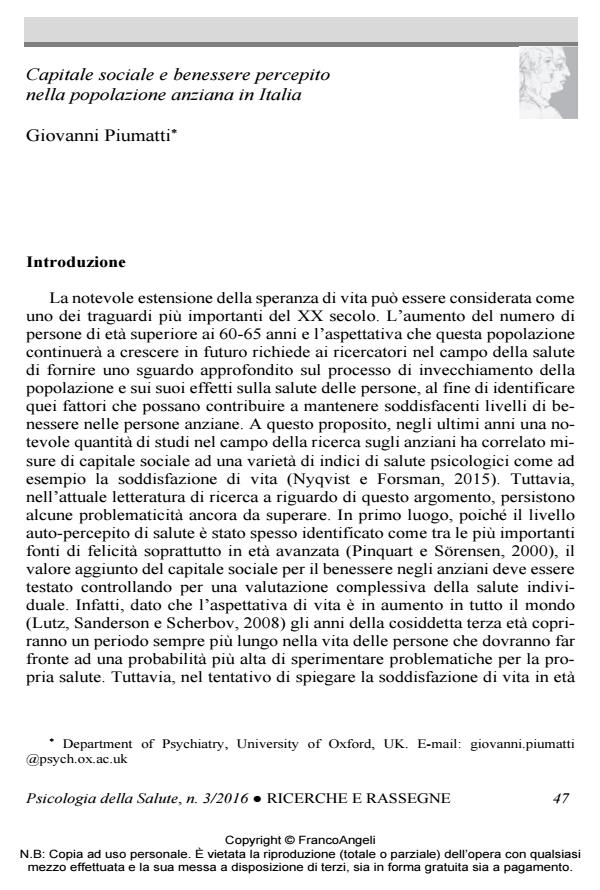Social capital and self-perceived well-being in the Italian elderly population
Journal title PSICOLOGIA DELLA SALUTE
Author/s Giovanni Piumatti
Publishing Year 2016 Issue 2016/3
Language Italian Pages 17 P. 47-63 File size 210 KB
DOI 10.3280/PDS2016-003003
DOI is like a bar code for intellectual property: to have more infomation
click here
Below, you can see the article first page
If you want to buy this article in PDF format, you can do it, following the instructions to buy download credits

FrancoAngeli is member of Publishers International Linking Association, Inc (PILA), a not-for-profit association which run the CrossRef service enabling links to and from online scholarly content.
Previous research has established significant positive associations between social capital and life satisfaction among elderly. This study aimed to obtain a deeper understanding of the relationship between different sources of social capital and well-being while controlling for an overall individual self-reported assessment of health status. A sample of 5.613 Italian residents was extracted from a national cross-sectional survey during 2013 in Italy, representative of the non-institutionalized population aged 60 years and over. Measures included self-reported assessment of health, community social capital and individual social capital. Hierarchical multiple regression analysis showed that (1) self-reported health contributes to a greater extent than social capital in explaining life satisfaction, and (2) both conceptualizations of social capital are independently associated with life satisfaction. In particular, individual social capital is a greater positive predictor of life satisfaction than community social capital in the current Italian sample. Implications for future research and interventions are discussed.
Keywords: Social capital, older people, life satisfaction, self-perceived health
- The mediation effect of political interest on the connection between social trust and wellbeing among older adults GIOVANNI PIUMATTI, DANIELE MAGISTRO, MASSIMILIANO ZECCA, DALE W. ESLIGER, in Ageing and Society /2018 pp.2376
DOI: 10.1017/S0144686X1700071X - Sospesi nel tempo. Inattività e malessere percepito in giovani adulti NEET Anna Parola, Lucia Donsì, in PSICOLOGIA DELLA SALUTE 3/2018 pp.44
DOI: 10.3280/PDS2018-003003 - Longitudinal Trends in Self-Rated Health During Times of Economic Uncertainty in Italy Giovanni Piumatti, in Social Indicators Research /2020 pp.599
DOI: 10.1007/s11205-019-02207-8
Giovanni Piumatti, Capitale sociale e benessere percepito nella popolazione anziana in Italia in "PSICOLOGIA DELLA SALUTE" 3/2016, pp 47-63, DOI: 10.3280/PDS2016-003003